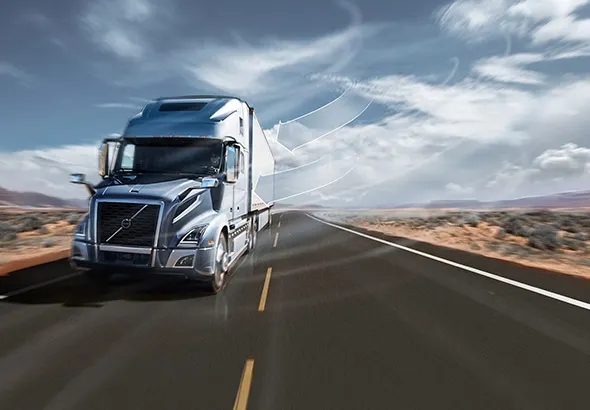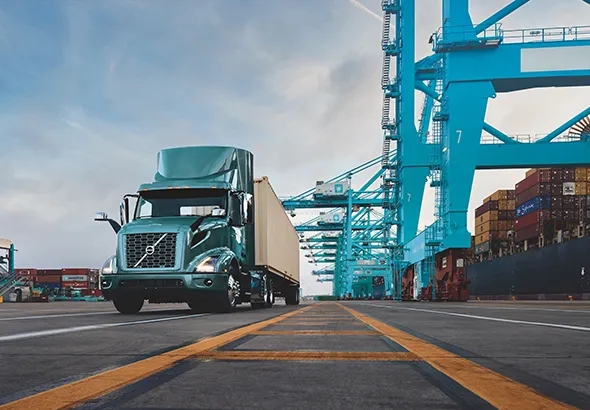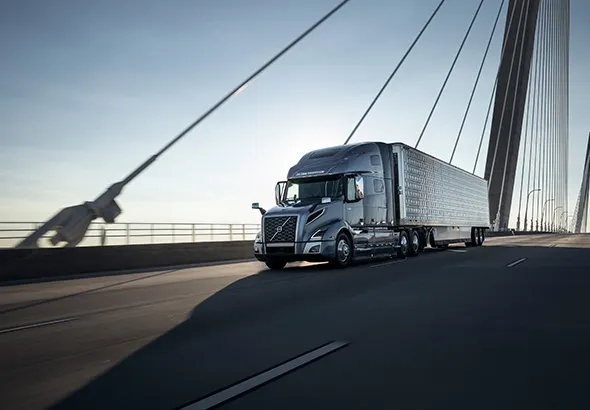Ever since the term “miles per gallon” burst into the public consciousness during the OPEC oil embargo of the 1970s, America has engaged in a fascinating and imaginative race to chase percentage increases, running them down until there are fewer and fewer slivers of percentages left to capture—and yet there always seem to be more! Another 0.3% gained from a drive train advance, 0.4% in combustion efficiency, 0.8% from improved aerodynamics, until pretty soon the engineers and designers have squeezed out more whole numbers and re-set the race for more energy efficiency.
MPG—making that number grow, increasing fuel efficiency—involves so many factors. It’s as enormous as the shape a truck punches out of the wind, and as miniscule as shaving a millimeter from the wave form of a piston. It’s as mathematically precise as gear ratios and still as hard to see as streams of data flowing through the air. It’s the hulking totality of the trucks people drive and the subtle differentiations in the way people drive them.
People think of fuel efficiency as a single numeric value—MPG—but so much goes into that one number. At Volvo Trucks, fuel efficiency is an entire philosophy developed around how customers operate their vehicles.
Start at the core
To understand this philosophy, start at the engine. A truck’s engine is, of course, where fuel is consumed and energy is unleashed. Volvo Trucks has made the D13 Turbo Compound engine (D13TC) standard on the most popular VNL models, because it is the most fuel efficient engine they’ve ever offered and it’s the perfect example of their philosophy in action.
When Volvo Trucks redesigned the D13TC they looked at everything—and optimized most of it. They changed the shape of the pistons so fuel sprayed into the chamber more evenly and is completely atomized, creating a more efficient burn.
Common rail fuel injection allowed more precise control of the timing, also creating more efficiency. Controlling all of these elements electronically instead of mechanically saved energy. Everywhere they looked, Volvo engineers found something to tweak, something they could do a little bit better. And that’s the point—they looked everywhere.
They even looked back in time. The turbo compound concept has been around for 100 years. It’s tried and true technology, an important consideration when you’re chasing efficiency, according to John Bartel, Volvo Trucks director, product strategy-driveline. “We’re always trying to keep a balance between additional cost and customer benefit,” Bartel says. “And you have to look at the added technology in terms of maintenance and the chance of that technology failing. That’s what led us to the turbo compound.”
"We’re always trying to keep a balance between additional cost and customer benefit."
John Bartel, Volvo Trucks director, product strategy-driveline
The D13TC engine takes previously wasted energy from the exhaust and transfers that to mechanical energy on the crankshaft. Instead of increasing horsepower, Volvo is using the additional energy to increase efficiency. The engine still provides 455 horsepower, but the amount of fuel it takes to reach that force is reduced. (See our in-depth profile of the D13TC on page 20 of this issue.)
Follow the power
From the engine, the energy released in fuel combustion is transferred to the powertrain. Conserving efficiency here is tricky with so many transfer points, each presenting opportunities for energy to spill away.
Volvo understands that customers tend to think about energy in two ways: as power and as cost. Sometimes the job a truck does requires more power, often at the cost of efficiency. So Volvo looked to offer the best of both. They developed drivetrain packages that placed power and efficiency in a relationship that allowed customers to make choices to meet their needs.
Volvo differentiated the way power is delivered. They customized a package that delivers maximum power—called Performance Mode—that delivers the most torque per horsepower rating available. They created Economy Mode, a balance between acceleration and drivability. And then they came out with Extra Efficiency Mode.
"Extra Efficiency Mode is really focused toward those customers who are extremely fuel efficiency-minded,” says Bartel. “Extra Efficiency has more torque limiting in the software parameters. It controls the rate of acceleration so you’ll go slower cresting the hills, instead of catching back up to speed going over the hill just to slow down on the other side with an engine brake. That’s a huge waste of energy.”
The shape of the thing
The object of the drivetrain, of course, is to push a 40-ton collection of metal and payload down the highway. That takes aerodynamics, thinking about the way air flows over a surface at speed, and finding ways to reduce drag. Today, software programs can simulate not only the aerodynamics of the truck’s exterior, but airflow through the grill, airflow through the radiator, how temperature affects airflow, how crosswinds shove the cab and trailer, and how much yaw a crosswind forces.
Engineers can simulate real world performance before they take a fully-built model into aerodynamic testing. They can see down to the millimeter when the exit angle off the edge of the wheel well keeps air flowing with the truck, not tripping off into turbulence that costs efficiency. They can see that all the leading edges in the opening of the grill at the bottom of the bumper direct air into the cooling package, rather than letting it dance around inside the hood cavity and create drag.
But shaping isn’t the only way to affect the fuel efficiency of a massive form. Why, for instance, create friction—often the enemy of fuel efficiency—when you don’t need it? A truck running empty or light doesn’t need all its axles, does it? So Volvo embraced the concept of Adaptive Loading, or lifting an axle off the road when a truck is running light. All that rubber, all that surface area friction, is subtracted from the very complex formula that determines how much fuel a truck burns.
 Steering Made Easy
Steering Made Easy
 Tougher Made Smarter
Tougher Made Smarter
 Cash in on Fuel
Cash in on Fuel